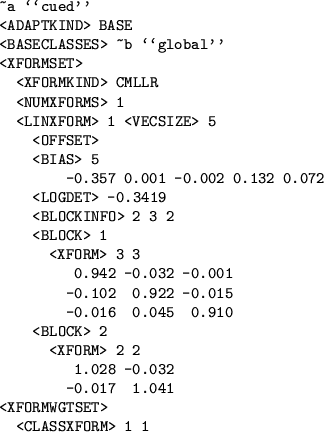 |
HEREST estimates the required transformation statistics and can either output a set of transformation models, or a single transform model file (TMF). The advantage in storing the transforms as opposed to an adapted MMF is that the TMFs are considerably smaller than MMFs (especially triphone MMFs). This section gives examples of the format that the transforms are stored in. For a description of the transform definition see section 7.10.
Figure 9.5 shows the format of a single transform. In the same fashion as HMMs all transforms are stored as macros. The header information gives how the transform was estimated, currently either with a regression class tree TREE or directly using the base classes BASE. The base class macro is then specified. The form of transformation is then described in the transformset. The code currently supports constrained MLLR (illustrated), MLLR mean adaptation, MLLR full variance adaptation and diagonal variance adaptation. Arbitrary block structures are allowable. The assignment of base class to transform number is specified at the end of the file.
The LOGDET value stored with the transform is twice the log-determinant of the transform9.3.